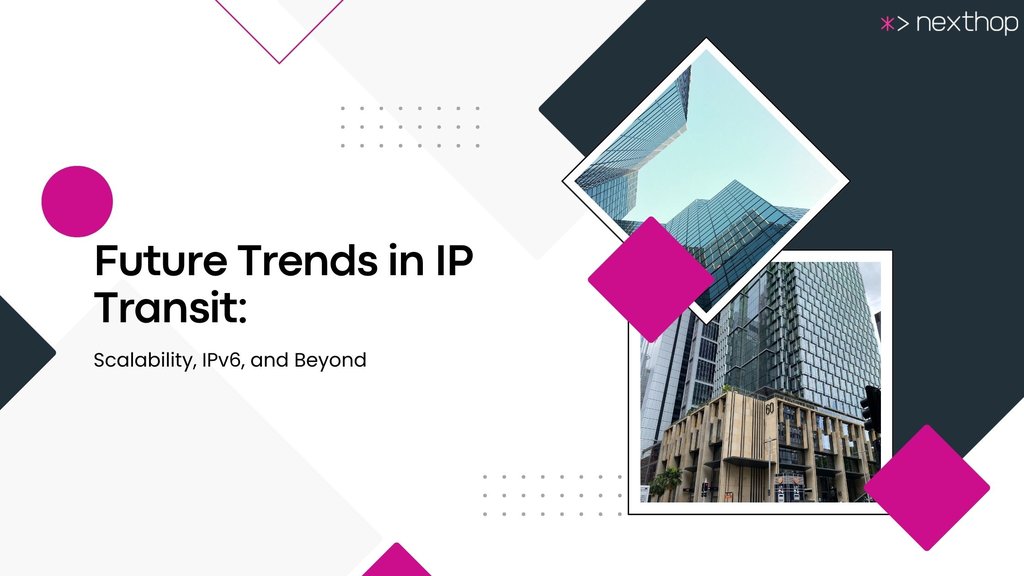The internet thrives on a robust highway system: IP transit. It allows different networks to seamlessly exchange data, ensuring global communication. Imagine data zipping across digital arteries, connecting the world like a bustling metropolis. IP transit, the essential infrastructure, provides pathways for this data flow – just like expressways crisscrossing a city.
As the digital landscape explodes with connected devices, bandwidth-hungry applications, and ever-increasing traffic, the need for a future-proof IP transit solution becomes paramount. We need faster, more reliable, and scalable connectivity. Embracing industry advancements ensures networks can accommodate future growth and technological leaps without disruptions or performance issues.
The Limits of Today's Infrastructure?
The current internet infrastructure, built on the foundation of IPv4, is struggling to keep pace with the ever-growing demands. IPv4, with its limited pool of IP addresses, is simply running out of steam. This has created a shortage, leading to workarounds like Network Address Translation (NAT) that introduce inefficiencies and security vulnerabilities.
The Power of IPv6
IPv6 emerges as the answer, offering a vast address space that can accommodate the ever-expanding internet. Transitioning to IPv6 is no longer optional; it's a necessity for a secure, scalable, and resilient internet. This shift unlocks new possibilities for innovation, enabling a truly connected world where collaboration and progress can flourish.
The transition became a global task. Everyone began adopting the new protocol and gradually became mandatory, the adaptation period, as challenging as it had been, has been a key element in ensuring boundless opportunities. A technological upgrade that created and shaped the world of network communication today.
Scalability, security, and performance are clear advantages of IPv6, making it a strong foundation for the future of IP Transit.
Security Built-In
Boasting security advantages over IPv4, the built-in features that enhance network protection surely surpass that of the capabilities of IPv4. IPv6 offers a more secure foundation for communication by inherently embedding security mechanisms within the protocol itself.
IPv6 significantly strengthens network security compared to IPv4. By embedding security mechanisms directly into the protocol, it offers built-in encryption and authentication (IPsec), improved device verification through headers, and simplified management. Additionally, advanced protocols like Secure Neighbor Discovery (SEND) prevent spoofing attacks, and Mobile IPv6 protocols ensure secure communication for mobile devices even when roaming.
Emerging Technologies Shaping the Future
Automating the Network: SDN and NFV
The future of IP transit hinges on agility and efficiency. Two key technologies, Software-Defined Networking (SDN) and Network Function Virtualization (NFV), are poised to revolutionize how IP transit networks are managed and optimized. Agility and efficiency. Keys to the future of IP transit. Two game-changers, SDN and NFV, will revolutionize network management.
SDN: Revolutionizing the Control Center
Imagine a network where the control plane (network intelligence) is separated from the data plane (data forwarding). This is the essence of SDN. By centralizing network control on a software-defined controller, SDN offers: Enhanced Flexibility (Easy configuration and traffic routing adjustments for rapid adaptation to changing demands), streamlined automation (Repetitive tasks become automated, freeing IT resources and optimizing network operations) and improved optimization (Real-time monitoring and traffic analysis enable optimized resource allocation and traffic prioritization.)
NFV: Virtualizing Network Functions
NFV (Network Function Virtualization) complements SDN by virtualizing network functions (firewalls, load balancing) traditionally on dedicated hardware. This shift to software brings: On-Demand scalability (network functions can be easily scaled to meet fluctuating traffic demands), faster service deployment: (new IP transit services are rapidly deployed as software applications), and reduced costs (Replacing hardware with software reduces capital and operational expenses.)
The synergy between SDN and NFV is particularly transformative. SDN provides centralized control, while NFV delivers flexible, on-demand network functions. This allows for dynamic provisioning and management of virtualized network services, catering to the evolving needs of IP transit.
Content Delivery Gets Closer: CDNs and Edge Computing
Imagine a world where websites load instantly, regardless of your location. This is the promise of geographically distributed content delivery, and two key technologies are making it a reality. Content Delivery Networks (CDNs) and edge computing. CDNs and edge computing are revolutionizing content delivery, bringing us a faster, more reliable, and enjoyable internet.
Content Delivery Networks (CDNs) are like geographically distributed warehouses for websites, bringing content closer to users for faster loading times. Edge computing goes a step further, placing processing power at the network's edge for ultra-low latency and potentially even offline functionality. Together, CDNs and edge computing create a powerful duo for seamless user experiences and optimized network performance.
Combining CDNs and edge computing creates a dynamic duo for content delivery: Seamless experience (CDNs deliver static content efficiently, while edge computing handles dynamic content processing locally, optimizing performance), enhanced user experience (this translates to faster loading times, lower latency, and potentially even offline functionality) and network optimization (by offloading tasks, these technologies improve overall network performance and resource allocation).
Building a Scalable and Secure Tomorrow
As we shape the future of the internet, prioritizing continuous innovation in IP transit is paramount. The ever-growing demand for bandwidth, security, and scalability necessitates a proactive approach to ensure a robust digital ecosystem. Embracing key trends is the answer.
By emphasizing continuous innovation in IP transit, we can meet the demands of a connected world and ensure a scalable, secure internet infrastructure for generations to come. Let's innovate together for a brighter digital future!






